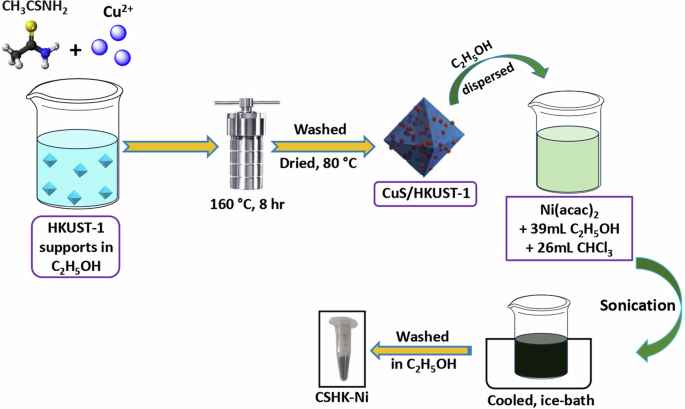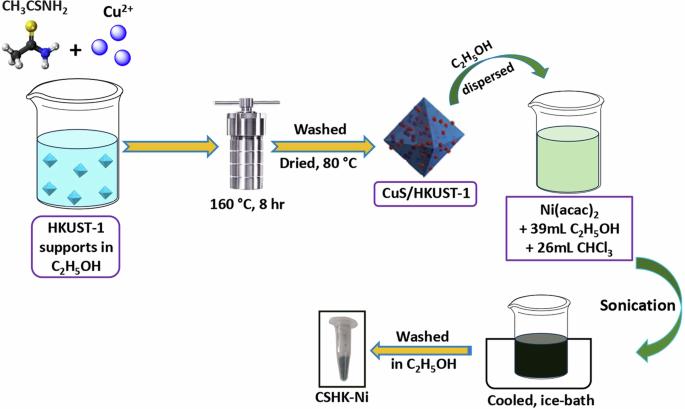Anchoring Ni(II) bisacetylacetonate complex into CuS immobilized MOF for enhanced removal of tinidazole and metronidazole
IF 10.4
1区 工程技术
Q1 ENGINEERING, CHEMICAL
引用次数: 0
Abstract
Here in this study, a novel ternary CuS/HKUST‒1/Ni(acac)2 nano photocatalyst (CSHK‒Ni) was developed through a facile modification of HKUST‒1 MOF with Ni(acac)2 metal complex and by immobilizing CuS into the metal-organic framework (MOF). The incorporation of CuS, a narrow bandgap semiconductor, is anticipated to allow easy excitation by visible-light and improve the photocatalytic potential of the formulated catalyst which is validated by the decrease in the bandgap energy from 3.10 eV of pristine MOF to 2.19 eV. Moreover, the anchoring of the metal complex improves the light harvesting behavior by increased conjugation. Photoluminescence studies provided evidence of the effective separation of the photoinduced charge-carriers, reducing the rate of recombination and enhancing the photocatalytic potential of the CSHK‒Ni nanocomposite. The engineered catalyst displayed remarkable efficiency in the degradation of nitroimidazole containing antibiotics, Tinidazole (TNZ) and Metronidazole (MTZ), via H2O2 assisted AOP achieving a maximum photocatalytic efficiency of 95.87 ± 1.64% and 97.95 ± 1.33% in just 30 min under irradiation of visible light at optimum reaction conditions. The possible degradation pathway was elucidated based on the identification of ROS and degradation intermediates via HR‒LCMS and quenching experiments. Meanwhile, the chemical oxygen demand (COD) and total organic carbon (TOC) removal were also examined, encompassing the discussing of various aspects including reaction conditions, influence of various oxidizing agents, competing species and dissolved organic substrates present in the wastewater, marking the novelty of the study. This research elucidated the role of the CSHK‒Ni nanocomposite as an interesting photocatalyst in the elimination of emerging nitroimidazole containing pharmaceutical pollutant under visible-light exposure, presenting an exciting novel avenue for a cleaner and greener environment in the days to come.


将双乙酰丙酮酸镍(II)络合物锚定到 CuS 固定化 MOF 中以提高对替硝唑和甲硝唑的去除率
在本研究中,通过用 Ni(acac)2 金属复合物对 HKUST-1 MOF 进行简单改性,并将 CuS 固定到金属有机框架 (MOF) 中,开发出了一种新型 CuS/HKUST-1/Ni(acac)2 三元纳米光催化剂 (CSHK-Ni)。CuS 是一种窄带隙半导体,预计它的加入将使催化剂更容易被可见光激发并提高其光催化潜能,原始 MOF 的带隙能从 3.10 eV 下降到 2.19 eV 也证明了这一点。此外,金属复合物的锚定增加了共轭作用,从而改善了光收集行为。光致发光研究证明,CSHK-Ni 纳米复合材料能有效分离光诱导的电荷载流子,降低重组率,提高光催化潜力。该工程催化剂在最佳反应条件下通过 H2O2 辅助 AOP 降解含硝基咪唑类抗生素替硝唑(TNZ)和甲硝唑(MTZ)的过程中表现出卓越的效率,在可见光照射下,仅 30 分钟的光催化效率就分别达到了 95.87 ± 1.64% 和 97.95 ± 1.33%。根据 HR-LCMS 和淬灭实验对 ROS 和降解中间产物的鉴定,阐明了可能的降解途径。同时,还考察了化学需氧量(COD)和总有机碳(TOC)的去除情况,包括反应条件、各种氧化剂的影响、废水中存在的竞争物种和溶解有机底物等多方面的讨论,这标志着该研究的新颖性。这项研究阐明了 CSHK-Ni 纳米复合材料作为一种有趣的光催化剂,在可见光照射下消除新出现的含硝基咪唑的制药污染物的作用,为未来更清洁、更环保的环境提供了一条令人兴奋的新途径。
本文章由计算机程序翻译,如有差异,请以英文原文为准。
求助全文
约1分钟内获得全文
求助全文
来源期刊

npj Clean Water
Environmental Science-Water Science and Technology
CiteScore
15.30
自引率
2.60%
发文量
61
审稿时长
5 weeks
期刊介绍:
npj Clean Water publishes high-quality papers that report cutting-edge science, technology, applications, policies, and societal issues contributing to a more sustainable supply of clean water. The journal's publications may also support and accelerate the achievement of Sustainable Development Goal 6, which focuses on clean water and sanitation.
 求助内容:
求助内容: 应助结果提醒方式:
应助结果提醒方式:


